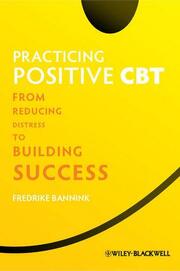-
Zusatztext
-
Practicing Positive CBT: From Reducing Distress to Building Success reveals a new therapeutic approach that combines traditional CBT with Positive Psychology and Solution-Focused Brief Therapy. By shifting the focus of therapy from what is wrong with clients to what it right with them and from what is not working to what is, Positive CBT creates a more optimistic process that empowers clients and therapists to flourish. * Increases client motivation and collaboration; allows therapeutic outcomes to be achieved in shorter timeframes and in a more cost-effective way * Covers theory and applications, and provides a wide range of stories, exercises and case studies * The author has a uniquely broad knowledge and experience as a therapist and trainer of CBT, PP, and SFBT
-
-
Kurztext
-
Recent decades have witnessed a surge in the development of competency-based, collaborative approaches to working with clients. Practicing Positive CBT: From Reducing Distress to Building Success reveals how traditional CBT can become Positive CBT, with a shift in the focus of therapy from what is wrong with clients to what is right with them, and from what is not working to what is. Drawing on insights and techniques from both Positive Psychology and Solution-Focused Brief Therapy, internationally renowned expert Fredrike Bannink first reveals how Positive CBT combines the best elements of change-based and meaning-based psychotherapeutic approaches to offer a new perspective on traditional CBT. Bannink then shows how the transition from traditional CBT to Positive CBT represents an important shift from problem analysis to goal analysis, from a focus on deficits and the learning of new behaviors to one that builds on resources and competences the client already possesses, and from reducing distress to building success. Combining theory and applications with a wide range of stories, practical exercises and case studies, Practicing Positive CBT offers groundbreaking insights on new approaches for the improvement of the psychological well-being of clients and therapists.
-
-
Autorenportrait
- InhaltsangabeAbout the Author ix Foreword x Preface xii Story: The Hundredth Monkey xiv Acknowledgments xv PART I THEORY 1 1 What is CBT? 3 Introduction 3 CBT Techniques 4 Empirical Evidence 5 2 What is Positive CBT? 7 Introduction 7 Shortcomings of the Problem-Solving Paradigm 8 Story 2.1: How to Not Be Unhappy 10 Towards a Strengths and Solutions Paradigm 10 Notes on Learning Theory 16 Story 2.2: I Can Choose 16 Changing Role of the Therapist 16 Differences Between Traditional CBT and Positive CBT - An Overview 17 Story 2.3: Looking for Problems? 17 3 Possibilities of Positive CBT 19 Introduction 19 What is Positive in Traditional CBT? 20 Possibilities of Positive CBT 31 4 Two Positive Sources 34 Introduction 34 Source 1: Positive Psychology 35 Story 4.1: The Power of Positive Emotions 41 Source 2: Solution-Focused Brief Therapy 41 Story 4.2: Do Something Different for a Change 42 Story 4.3: Working from the Future Back 49 Short Comparison Between Positive Psychology and Solution-Focused Brief Therapy 50 Empirical Evidence 50 Neuroscience 51 Story 4.4: The Drip System 55 The Body 59 PART II APPLICATIONS 61 5 Enhancing the Therapeutic Alliance 63 Introduction 63 Building a Positive Alliance 64 Offering Acknowledgment 65 Story 5.1: Acknowledging the Problem 66 Enhancing Hope 66 Story 5.2: The Archer 69 Story 5.3: The Power of Hope 70 Reinforcing Strengths and "What Works" 70 Enhancing Cooperation 72 Story 5.4: Misery I Love You! 74 Story 5.5: Everybody, Somebody, Anybody, and Nobody 76 6 Assessment 77 Introduction 77 Case Conceptualization 77 Assessing Goals 79 Story 6.1: Top Performers 86 Assessing Problems, Complaints, and Constraints 87 Assessing Strengths and Resources 88 Assessing Progress, Motivation, Hope, and Confi dence 90 Story 6.2: At the Car Wash 92 Assessing Motivation to Change 93 Positive Self-monitoring 93 Positive Functional Behavior Analysis 95 7 Changing the Viewing 99 Introduction 99 Acknowledging Feelings and the Past 99 Changing What the Client is Paying Attention to 101 Story 7.1: Finding the "Bright Spots" 102 Story 7.2: The Dog I Feed Most 110 Story 7.3: Shake it Off and Step Up 111 Focusing on What the Client Wants in the Future 114 Challenging Unhelpful Beliefs 115 Using a Spiritual Perspective 124 8 Changing the Doing 128 Introduction 128 Story 8.1: For a Change Do Something Different 128 Changing Repetitive Patterns 129 Story 8.2: Sail Away From the Safe Harbor 130 Noticing What the Client is Doing When Things are Going Better 131 Story 8.3: Chocolate-chip Cookies 133 9 Changing the Feeling 138 Introduction 138 Reducing Negative Emotions 138 Building Positive Emotions 140 Balancing Positive and Negative Emotions 145 Story 9.1: Consider a Sail-boat 147 Story 9.2: The Nun Study 148 Positive Emotions in the Medical Setting 148 10 Homework Assignments 152 Introduction 152 General Suggestions 153 Basic Homework Assignments 156 Selfmonitoring 157 Behavioral Experiments 160 Routine Outcome Measurement 165 Story 10.1: Brilliant Insights 166 Refl ecting on the Session 170 11 Subsequent Sessions 173 Introduction 173 Progress 174 Behavior Maintenance 180 Failures 185 Story 11.1: Ten Million Dollars Lost 190 Concluding Therapy 190 12 Role of the Positive CBT Therapist 193 Introduction 193 Watering the Flowers 193 Role of the Positive CBT Therapist 194 Supertherapists 196 Easy and Fun 198 The Alliance Revisited 200 Microanalysis 200 Benefi ts for Therapists 203 PART III MORE APPLICATIONS 207 13 Positive CBT with Couples and Groups 209 Introduction 209 Positive CBT with Couples 210 Story 13.1: The Norway Feedback Project 213 Positive CBT with Groups 215 14 Positive CBT with Child
Detailansicht
Practicing Positive CBT
From Reducing Distress to Building Success
ISBN/EAN: 9781119952701
Umbreit-Nr.: 3208507
Sprache:
Englisch
Umfang: 256 S.
Format in cm:
Einband:
gebundenes Buch
Erschienen am 14.09.2012
Auflage: 1/2012


